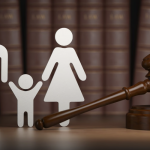There were 689,308 divorces in the U.S. in 2021. While some divorces don’t involve children, many do. When kids are a part of a divorce, the couples must make custodial arrangements. However, there are different types of custodial arrangements. Two are most common: sole custody vs. legal guardianship. Do you know the differences between these?
If you’re getting divorced with children, learning the differences is helpful as you navigate through this event. Keep reading to learn the differences.
Sole Custody Refers to Rights and Responsibilities
Sole custody is a legal term referring to a parent receiving rights to a child. The child must be a biological or legal child of the parent with sole custody rights.
When a parent receives sole custody rights, they have control over the child. They can make decisions for the child and must care for and provide for them.
Many couples use joint custody instead of sole custody. Joint custody gives both parents rights and responsibilities for and to the children.
Physical Custody Differs From Legal Custody
Custody laws also differentiate between physical custody and legal custody. Both give rights to a parent for a child, but the rights they receive are different.
Physical custody refers to the rights of a parent to have the child live with them. When a parent receives physical custody rights, they are responsible for caring for the child daily.
Parents can split physical custody, or it might be awarded to only one parent.
Legal custody gives a parent the right to make decisions for the child. If only one parent has legal sole custody, they can make decisions themselves. They do not have to consult the other parent.
In many cases, both parents receive legal custody rights. When parents share legal custody, they must consult each other when making important decisions for the kids.
A family lawyer can help you understand this more thoroughly. They can explain the differences in depth and help you fight for custody rights of your child.
Legal Guardianship Is for Someone Other Than a Parent
After learning about custody, you might ask, “What is guardianship?” Legal guardianship refers to a non-parent receiving rights to a child.
This might be a grandparent, aunt, uncle, or friend. It could also be a foster parent or someone else.
When someone other than the parent receives rights to a child, the court appoints the person as a legal guardian.
Legal guardianship results in the same rights as sole custody. It also comes with the same responsibilities. The only difference is that courts do not appoint biological parents as legal guardians.
Learn More About Sole Custody vs. Legal Guardianship
Divorces are never easy, especially with children. As you navigate your divorce, consider the difference between sole custody vs. legal guardianship. Learning these can help you assess what’s best for your children.
Consulting a family attorney is helpful during this time, and we can help. Reach out to us at Crosson Richetti & Daigle. We are a family law firm and can provide advice and legal services to assist you in your case.











